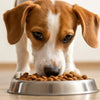How Much Kibble Do I Feed My Dog? A Comprehensive Guide for Pet Owners
- Houndsy
Table of Contents
- Introduction
- Understanding Your Dog's Nutritional Needs
- Finding the Right Kibble
- How to Determine Portion Sizes
- The Importance of Consistency and Routine
- Conclusion
- FAQs
Introduction
Did you know that according to the Association for Pet Obesity Prevention, over 59% of dogs in the United States are overweight or obese? This staggering statistic highlights a critical issue faced by many dog owners: determining how much kibble to feed our furry friends. Striking the right balance in our dogs' diets is vital for their health, energy levels, and overall well-being.
As devoted pet parents, we understand that feeding our dogs properly is not just about filling their bowls; it's about providing them with the nutrition they need to thrive. In this guide, we will explore the factors that influence how much kibble we should feed our dogs, the importance of portion control, and how Houndsy's innovative solutions can make this process easier and more enjoyable.
By the end of this blog post, we will equip you with the knowledge to make informed decisions about your dog's diet, ensuring they receive the right amount of kibble tailored to their unique needs. So, let’s dive into the essentials of dog feeding, including age, size, activity level, and more.
Understanding Your Dog's Nutritional Needs
Feeding our dogs the right amount of kibble is crucial for their health and well-being. However, determining the appropriate amount can be confusing due to the various factors that play a role in our dogs' dietary needs. Here, we'll discuss the key elements that influence how much kibble we should feed our dogs.
1. Age
A dog's age significantly impacts its nutritional requirements. Puppies, adult dogs, and senior dogs have different needs:
- Puppies: Growing puppies require more calories, protein, and essential nutrients to support their rapid growth and development. They typically need to be fed three to four times a day, with the amount of food based on their weight and age.
- Adult Dogs: Once dogs reach adulthood (usually around 1 year old), their nutritional needs stabilize. Most adult dogs do well with two meals a day, and the amount of kibble should be adjusted based on their activity level and overall health.
- Senior Dogs: As dogs age, their metabolism slows down, and they may become less active. Senior dogs often benefit from lower-calorie diets to prevent weight gain. Their daily food intake should be carefully monitored, and feeding smaller, more frequent meals can be helpful.
2. Size and Breed
The size and breed of our dogs play a significant role in determining how much kibble they need:
- Small Breeds: Small dogs typically require more calories per pound of body weight than larger breeds. For example, a small breed dog weighing 10 pounds may need around ¾ to 1 ⅓ cups of food per day.
- Medium Breeds: Medium-sized dogs, weighing between 30 to 50 pounds, generally need around 1 ¾ to 2 ⅔ cups of food per day.
- Large Breeds: Large dogs (60 to 100 pounds) require approximately 3 to 4 ½ cups of kibble daily, while extra-large breeds over 100 pounds may need 4 ½ cups plus an additional ¼ cup for every extra 10 pounds.
3. Activity Level
A dog's activity level is another essential factor in determining the right amount of kibble:
- Active Dogs: Dogs that engage in regular exercise or have demanding jobs (like herding or hunting) need more calories to fuel their energetic lifestyle. They may require up to 20% more food than less active dogs.
- Less Active Dogs: Dogs that are less active or tend to be couch potatoes may need fewer calories. Monitoring their weight and adjusting their food intake can help maintain a healthy weight.
4. Body Condition Score
Understanding a dog's body condition score (BCS) is a practical way to assess whether they are at a healthy weight. The BCS system typically uses a scale of 1 to 9, where:
- 1-3: Indicates underweight
- 4-5: Indicates ideal weight
- 6-9: Indicates overweight to obese
If your dog falls into the underweight category, they may require more food, while overweight dogs will need a caloric reduction. Regular vet check-ups can assist in monitoring your dog's BCS and adjusting their diet accordingly.
5. Health Status
A dog's health status can also affect its dietary needs. Conditions such as diabetes, heart disease, or allergies may require specialized diets or adjusted caloric intake. Pregnant or nursing dogs have higher energy demands and typically need more food to support their health and that of their puppies.
Finding the Right Kibble
Once we understand our dogs' nutritional needs, the next step is selecting the right kibble. Not all dog foods are created equal, and the quality of the kibble directly influences our pets' health. Here are some considerations for choosing kibble:
1. Quality Ingredients
Opt for high-quality kibble that contains real meat as the primary ingredient. Avoid foods with fillers, artificial preservatives, and low-quality by-products. Reading labels and researching brands can help ensure that we're providing the best nutrition for our furry companions.
2. Nutritional Balance
A well-balanced kibble should contain an appropriate mix of proteins, fats, carbohydrates, vitamins, and minerals. Look for products that meet the AAFCO (Association of American Feed Control Officials) guidelines, ensuring that the food is nutritionally complete for your dog's life stage.
3. Specific Formulations
Some dog breeds have specific nutritional requirements, and certain kibble formulations cater to those needs. For example, large breed formulas often contain ingredients that support joint health, while sensitive stomach formulas may include easier-to-digest components for dogs with gastrointestinal issues.
How to Determine Portion Sizes
Now that we know the factors that influence our dog's dietary needs and how to choose the right kibble, it’s time to figure out how much to feed them. Here are some steps to help you determine the appropriate portion sizes:
1. Read the Feeding Guidelines
Most dog food packaging includes feeding guidelines based on the dog's weight. These guidelines provide a starting point, but remember that they are only general recommendations. You may need to adjust the serving size based on your dog's specific needs.
2. Calculate Daily Portions
After determining the total daily amount of kibble your dog should receive, divide that amount by the number of meals you plan to feed them each day. For example, if your dog requires 2 cups of kibble per day and you feed them twice daily, each meal would consist of 1 cup.
3. Monitor Weight and Adjust
Regularly monitor your dog's weight and body condition. If your dog is gaining or losing weight unexpectedly, adjust their food intake accordingly. It's also wise to consult your veterinarian for personalized recommendations based on your dog's health and lifestyle.
4. Use a Calorie Calculator
For a more precise approach, consider using an online calorie calculator designed for dogs. These tools take into account a variety of factors, including age, breed, activity level, and current weight, to provide tailored recommendations.
The Importance of Consistency and Routine
Consistency in feeding schedules plays a crucial role in our dogs' well-being. Establishing a routine helps regulate our pets' digestion and prevents overeating or underfeeding. Here are some tips for maintaining a consistent feeding routine:
1. Set Regular Meal Times
Feed your dog at the same times each day to create a predictable routine. Most adult dogs thrive on two meals a day, while puppies may need three to four meals.
2. Avoid Free-Feeding
Free-feeding, where food is left out for dogs to graze, can lead to overeating and weight gain. Instead, serve measured portions during scheduled meal times.
3. Use Automatic Feeders
For added convenience and consistency, consider using an automatic dog feeder. Houndsy's Kibble Dispenser, for instance, allows pet owners to easily dispense measured portions at standing height, eliminating the need for bending and ensuring accurate servings every time. Explore our Houndsy Kibble Dispenser for a stylish and functional solution to your dog's feeding routine.
Conclusion
Determining how much kibble to feed our dogs is a vital aspect of responsible pet ownership. By understanding the factors influencing our dogs' nutritional needs—such as age, size, activity level, and health status—we can provide them with the right amount of food to support their health and happiness.
Selecting high-quality kibble and establishing a consistent feeding routine are essential steps in this process. With the right knowledge and tools, such as the innovative Houndsy Kibble Dispenser, we can simplify and elevate our dog-feeding experience, ensuring our furry friends thrive.
As we reflect on our dogs' feeding routines, let's ask ourselves: Are we providing them with the right amount of kibble? Are we considering their unique needs, and are we committed to maintaining a healthy feeding regimen?
By making informed choices and utilizing helpful tools, we can ensure that our beloved companions receive the nutrition they deserve.
FAQs
Q: How do I know if I'm feeding my dog the right amount of kibble?
A: Start by checking the feeding guidelines on your dog food's packaging, which are typically based on your dog's weight. Monitor your dog's weight and body condition score, and consult your veterinarian for personalized advice.
Q: Can I use a calorie calculator to determine how much kibble to feed my dog?
A: Yes! Online calorie calculators can help you estimate your dog's daily caloric needs based on factors such as age, breed, activity level, and weight.
Q: How often should I feed my dog?
A: Most adult dogs do well with two meals per day, while puppies may require three to four meals. Establishing a consistent feeding schedule is crucial for your dog's well-being.
Q: What should I do if my dog is overweight?
A: If your dog is overweight, consult your veterinarian for guidance on adjusting their diet and caloric intake. They may recommend a weight loss plan and specialized food to help your dog reach a healthy weight.
Q: How can Houndsy's Kibble Dispenser help with my dog's feeding routine?
A: The Houndsy Kibble Dispenser allows for easy portion control at standing height, ensuring that you dispense the right amount of kibble without the need for bending. Explore our Houndsy Kibble Dispenser for a convenient and stylish solution to your dog's feeding needs.












